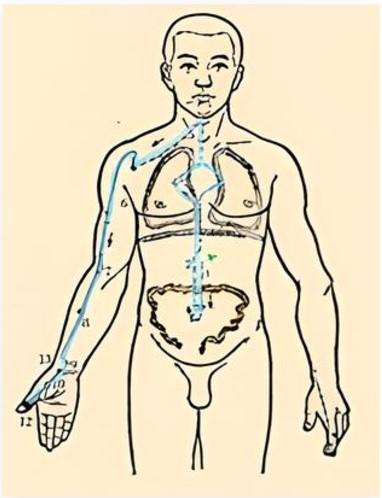The lungs are located in the chest, they connect to the throat and open into the nose. Besides breathing and gas exchanges, TCM claims that the
lungs are also responsible for regulating various pathways, ensuring the smooth flow of
qi (vital energy), water, and body body waste. The skin, hair and nose are important areas for observing lung-related conditions.
The
lung meridian is communicated with the
large intestine meridian, meaning they have an internal-external relationship and can affect each other when one is diseased. Common symptoms of lung-related issues in TCM include coughing, shortness of breath, chest pain and coughing up blood.
Below are common disharmonies of the lung and large intestine:
Deficiency of lung qi
Feeble coughing, asthmatic breathing,
breath shortness, that are worse on activity. Others include clear and thin sputum, a weak voice, sweating, pale and lusterless complexion, fatigue, sensitive to wind and cold temperatures. Individuals can catch flu and cold easily. On examination. the tongue is pale with a white coating, the pulse is forceless.
Western Medicine reference: Chronic bronchitis.
Deficiency of lung yin
Dry coughing, or coughing with little sticky sputum, dry mouth and throat, skinny appearance, fever occurring at the same time of day, hot sensation in palms and soles, night sweating and red cheeks. In serious cases, there may be coughing up bloody sputum, and hoarse voice. On examination, the tongue is red with a little coating, the pulse is thready and rapid.
Western Medicine reference: Lung tuberculosis.
Wind-cold restraining lung
Slight chills and fever, unable to sweat, head and body aches, cough with a thin white sputum, nasal congestion and runny nose. On examination, the tongue coating is thin and white, the pulse is floating and tense.
Western Medicine reference: Acute upper respiratory infection.
Wind-heat invading lung
Coughing with yellow and thick sputum, heavy breathing, nasal congestion with yellowish turbid discharges, thirst, fever, sore throat, headache, and slight aversion to wind and cold temperatures. On examination, the tongue has a red tip and covered by yellow and thin coating, the pulse is floating and rapid.
Western Medicine reference: Acute bronchitis, and pharyngitis.
Dry-heat damaging lung
Dry coughing or coughing with little sticky sputum, dry nose and mouth and sore throat. In serious cases, there may be chest pain when coughing, sensitive to cold temperatures, fever or spitting up blood. On examination, the tongue is red and dry with a thin yellow coating, the pulse is rapid.
Western Medicine reference: Acute bronchitis and pharyngitis.
Phlegm-heat congesting lung
Coughing, asthmatic and heavy breathing, spitting up turbid yellowish-green sputum, thirst, sensitive to cold temperatures, fever, chest pain, dark yellow urine and constipation. In serious cases, there may also be bloody foul-smelling pus. On examination, the tongue is red with a yellow and greasy coating, the pulse is rolling and rapid.
Western Medicine reference: Pneumonia, pulmonary emphysema and bronchiectasis.
Turbid-phlegm obstructing lung
Coughing, asthmatic breathing with copious and clear sputum, chest tightness or palpitations, wheezing, and cannot lie flat in severe cases. On examination, the tongue coating is thin and white, and the pulse is rolling.
Western Medicine reference: Chronic bronchitis.
Cold-fluid stagnating lung
Coughing, asthmatic breathing with copious foamy sputum, cannot lie flat in severe cases, chest tightness, gurgling in throat, sensitive to cold temperatures, that the symptoms will get worse in cold environments. This syndrome pattern may also be accompanied by an
exterior syndrome. On examination, the tongue is white, slimy and greasy; the pulse is taut and rolling or accompanied with floating.
Western Medicine reference: Asthmatic bronchitis.
Fluid exhaustion in large intestines
Constipation, sometimes the stools are like dry small pellets that are too difficult to pass out, dry mouth and throat, dizziness and foul breath. On examination, the tongue is red with a yellow dry coating, the pulse is thready.
Western Medicine reference: Habitual constipation.
Damp-heat of large intestine
Abdominal pain,
tenesmus, diarrhea, passing mucous or red jelly-like stools or watery stools. There is also fever, thirst, burning sensation in the anus, scanty and yellow urine, and sensitive to cold temperatures. On examination, the tongue is red with yellow and greasy coating; the pulse is rolling and rapid or hesitant and rapid.
Western Medicine reference: Acute enteritis and bacterial dysentery.



